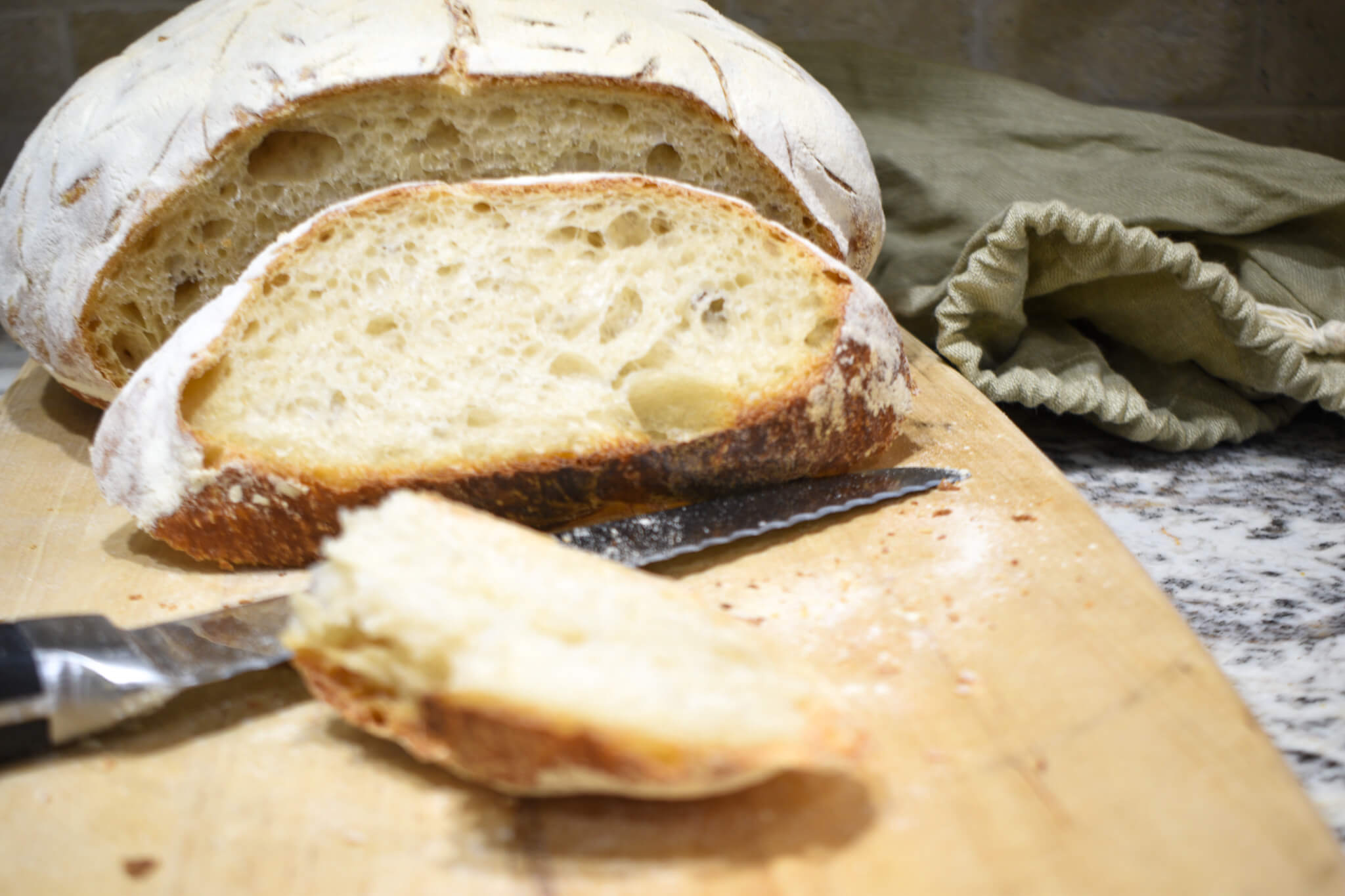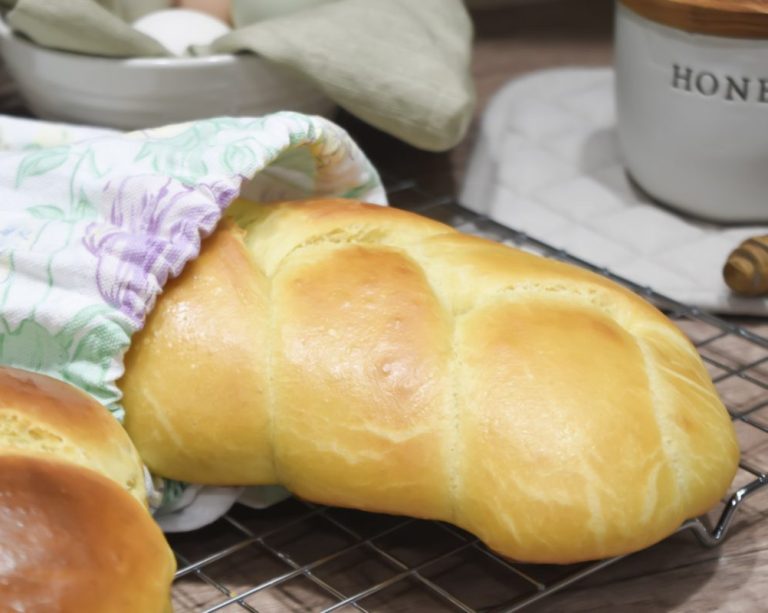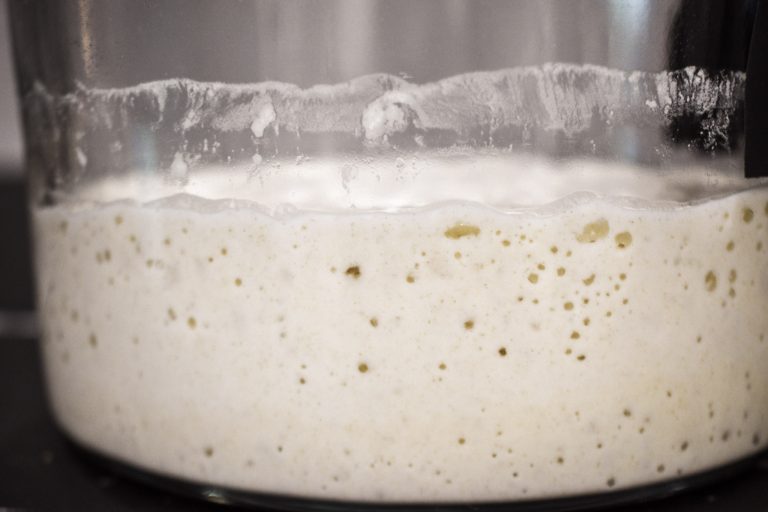How Long Does Sourdough Bread Last? Best Storage Tips (+10 FAQs answered!)
Let’s be honest—baking sourdough takes time. Like, days. So the last thing you want is for your beautiful loaf to go stale or moldy before you’ve even had a chance to finish it. I’ve been there… excitedly slicing into a fresh loaf one day, only to find it rock-hard or worse—fuzzy with mold—by day three. So, how long does sourdough bread last?
I put together this guide on how to store sourdough bread the right way just for you! Whether you want to keep your crust crunchy, extend your sourdough shelf life, or figure out what to do with those last stale slices, I’ve got you. I’ll walk you through everything I’ve learned from baking (and sometimes ruining) loaf after loaf—plus easy tips for freezing, storing without plastic, and spotting when your bread’s past its prime.
If you’ve ever wondered, “Does sourdough bread go bad faster than store-bought?” or “How long does homemade sourdough actually last?” — you’re in the right place.
Let’s get into it!
What Affects the Shelf Life of Sourdough Bread?
I used to think bread was bread—make it, eat it, done. But sourdough? Totally different ball game when it comes to how long it lasts. The shelf life of sourdough bread is affected by a combo of what’s in it and how it’s stored after baking.
Natural Fermentation vs. Commercial Yeast: Why It Matters
Okay, so this blew my mind when I first started baking. Sourdough, with its natural fermentation process, actually lasts longer than most store-bought loaves that use commercial yeast. That’s thanks to the lactic acid bacteria and wild yeasts in the starter, which create a more acidic environment. Turns out, that acidity helps fight off mold a little longer. It’s not magic, but it gives you an extra day or two.
Compare that to commercial yeast bread, which goes stale fast and molds quickly unless it’s packed with preservatives.
Ingredients That Extend or Shorten Shelf Life
Here’s where things get surprisingly specific. High-hydration sourdough (like 75%+ water) tends to go stale slower, but it can mold faster if the environment’s humid. Salt also plays a role—not just for flavor but as a natural preservative. No salt? That loaf’s shelf life shrinks.
I’ve also noticed that whole grain or rye sourdoughs mold a bit faster than plain white flour ones. Not sure why, maybe the oils in the grains? Either way, if I’m making a loaf I want to keep around for a while, I go with a basic white sourdough.
Humidity, Temperature, and Kitchen Environment
Where you store your sourdough matters a lot. I live in a pretty humid area, and during summer, bread will start to feel tacky or even grow mold faster than usual. If your kitchen’s over 75°F and humid, expect a shorter sourdough shelf life unless you’re storing it right.
In the winter, I can leave it out wrapped in a linen bread bag on the counter for 4–5 days, no problem. But in July? I gotta rotate between paper wrapping and checking it daily. Also, don’t stick it in a plastic bag unless you want it to get soggy by morning.
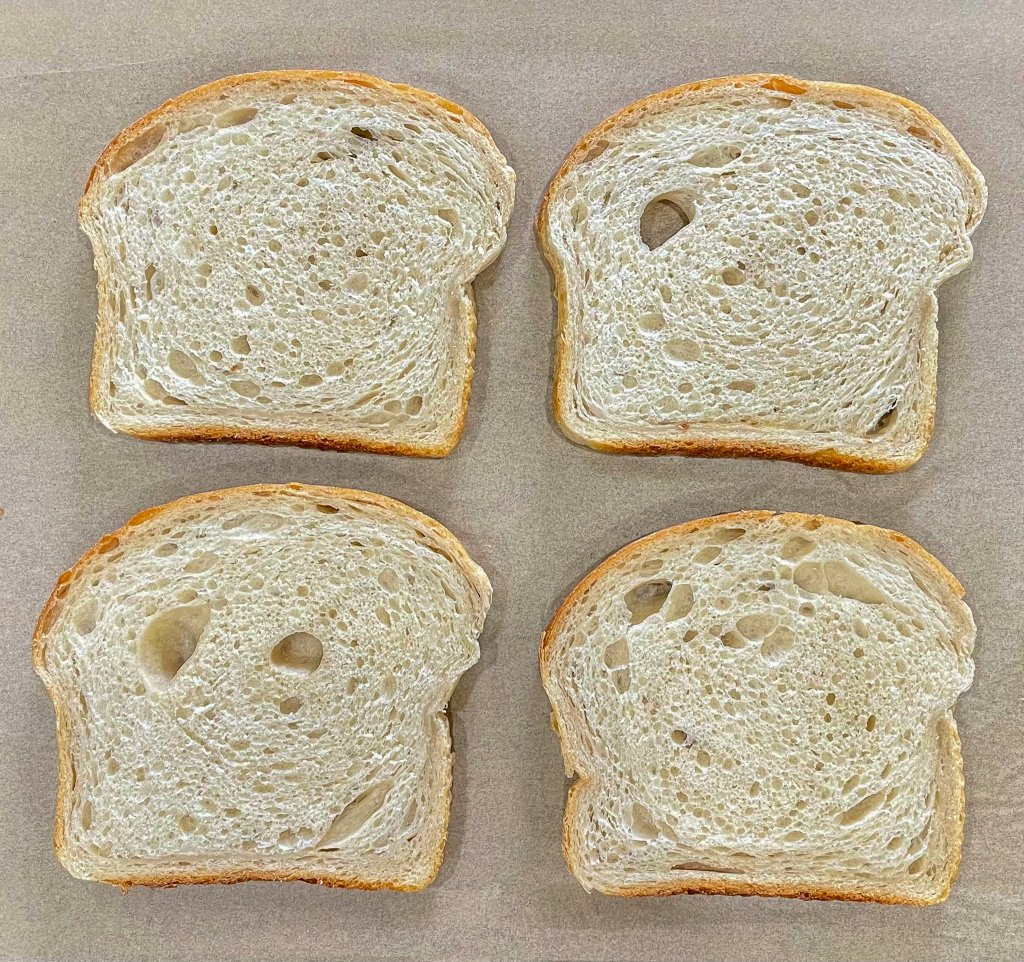
How Preservatives in Store-Bought Bread Differ from Homemade Sourdough
This part makes me cringe. Store-bought breads are often loaded with ingredients I can’t even pronounce. Calcium propionate, sodium stearoyl lactylate… like, what even? These preservatives stretch out the shelf life artificially, sometimes up to two weeks. But the trade-off is taste and texture. And they mess with digestion for a lot of folks.
Homemade sourdough has none of that junk. Just flour, water, salt, and starter. So yeah, it won’t last forever, but you get that clean flavor and better gut health. And honestly? I’d rather freeze a slice than eat something that’s been “fresh” on a shelf for 12 days.
How Long Does Sourdough Bread Last at Room Temperature?
So, how long can you leave sourdough bread out on the counter before it goes bad? I’ve tested this more times than I can count (and yes, I’ve eaten my fair share of stale bread). Most homemade sourdough stays fresh for 3 to 5 days at room temperature. After that, the crust gets hard, and the inside starts drying out.
Now, if your kitchen is super warm or humid, it might only last 2–3 days. And if your loaf has a lot of moisture (like those really soft, fluffy kinds), it might mold faster. Drier sourdough with a thick crust usually stays good longer.
Factors That Influence Freshness (Crust Type, Hydration, Etc.)
The crust makes a big difference. Crusty loaves—like the ones with that deep golden, crackly outside—stay fresher longer. They sort of protect the inside from drying out too fast.
And the water content (also called hydration) really matters. If your dough has lots of water in it, it might feel soft and squishy at first, but it can go stale quicker. I once made a 78% hydration loaf (fancy way of saying it had lots of water), and it was awesome the first two days… then it got kind of gummy and weird by day four.
Also, sourdough with extras like cheese or fruit? Those spoil even faster. I don’t leave those out more than two days, tops.
Tips for Storing Sourdough on the Counter Without Plastic
Here’s the trick: Don’t store your sourdough in plastic. I learned this the hard way when I wrapped mine in a plastic bag and found it all soft and damp the next morning. Plastic traps moisture, which makes the crust soggy and can cause mold.
Instead, wrap your loaf in a clean cotton or linen towel, or use a linen bread bag. That lets it breathe while keeping it from drying out too fast. I like to put mine cut-side down on a wooden cutting board and cover it with a towel. It works surprisingly well.
Another idea? Use a bread box. It keeps the bread at a steady temp and blocks out too much air.
And if the crust starts to go a little stale? You can always warm it up in the oven for a few minutes to bring it back to life. Just be sure it hasn’t gone bad—more on that in a later section!
Refrigerating Sourdough: Good or Bad Idea?
Okay, let’s talk about the fridge. You might think, “Hey, if I want my sourdough to last longer, I’ll just pop it in the refrigerator.” I thought the same thing at first… but nope. Refrigerating sourdough bread actually makes it go stale faster.
I didn’t believe it until I tried it myself. I put a fresh loaf in the fridge overnight and pulled it out the next morning, all excited. But when I sliced into it? It was dry and weirdly chewy. Total letdown.
Why Refrigeration Can Dry Out Your Loaf Faster
Here’s what’s going on: cold air in the fridge makes the starches in the bread get hard really fast. This is called retrogradation (yeah, it sounds fancy, but it just means the bread gets stiff). That’s why the fridge is not your best friend when it comes to sourdough storage.
Even if you wrap it up tightly, your crust will lose its crunch, and the inside will feel stale sooner than if you just left it on the counter.
When It Might Make Sense (e.g., Hot Climates)
Now, there are times when putting sourdough in the fridge makes sense. If you live somewhere super hot or humid—like Florida in the summer—bread can mold fast. If your sourdough is going moldy after two days when you leave it on the counter, it’s better to keep it cool than risk mold.
Another time it might be okay is if you’ve already sliced it and you’re not going to eat the rest for a few days. Even then, I’d say: freeze it instead (we’ll get into that next).
Best Practices If You Must Refrigerate
If you have to refrigerate it, here’s what worked best for me:
- Wrap the sourdough tightly in a beeswax wrap or a clean towel, then put it in a paper bag.
- Stick that inside a container or a bread box to protect it from cold air.
- Don’t store it near anything with strong smells—bread will absorb odors like a sponge.
When you’re ready to eat it, you can warm up slices in the oven or toaster to soften them. It won’t be exactly like fresh, but it’s still way better than tossing it out.
Up next, I’ll show you how to freeze sourdough the right way so you don’t lose that beautiful crust or chewy inside. Let’s gooo!
Freezing Sourdough for Long-Term Storage
Freezing sourdough? Yes, you totally can. And it’s honestly one of the best ways to make your sourdough last longer without losing flavor or texture. I didn’t use to freeze bread because I thought it would ruin it. But then I tried it—properly—and now I always freeze part of my loaf right after baking.

How to Freeze Whole or Sliced Sourdough Correctly
You’ve got two good options: freeze the whole loaf or freeze it in slices. I’ve done both, and each has its perks.
If you freeze the whole loaf:
- Let it cool completely first. Seriously, no steam should be left or it’ll get ice crystals.
- Wrap it tight in plastic wrap or beeswax wrap, then stick it in a freezer-safe bag.
- If you’re extra cautious, double wrap it to prevent freezer burn.
Freezing slices is great if you only want a little at a time:
- Slice it before freezing (I usually do medium-thick slices (about ½in.) so they don’t break when thawing).
- Layer parchment paper between slices so they don’t stick together. This is a good technique if you only eat a few slices per day.
- Wrap them in foil or put them in a zip-top freezer bag, squeeze out the air, and toss them in the freezer.
How Long Sourdough Lasts in the Freezer (Up to 3 Months)
Frozen sourdough keeps pretty well for about 2 to 3 months. After that, it doesn’t go bad exactly, but the texture starts to change and it may taste kind of flat.
I like to label my freezer bags with the date so I don’t lose track. Learned that after biting into a slice from… who-knows-when. It tasted like freezer air. Don’t recommend it.
How to Thaw and Reheat Without Ruining the Crust
Here’s the good part: thawing it is super easy if you do it right.
For whole loaves:
- Take it out of the freezer, unwrap it, and let it thaw on the counter (on a wire rack if you have one).
- Once it’s thawed, pop it in a 350°F oven for 10–15 minutes to bring the crust back to life.
For slices:
- You can toss a slice straight into the toaster. It thaws and crisps up at the same time. Boom, done.
- Or let it sit at room temp for 15–30 minutes, then warm it in a toaster oven if you want that crusty edge.
One time I microwaved a slice and yikes—don’t do that unless you like gummy bread. It’s better to wait the extra few minutes and reheat it properly.
Freezing sourdough is honestly a great way to reduce food waste and always have homemade bread on hand. Up next, let’s talk about how to know when it’s time to say goodbye to your loaf…
How to Tell if Sourdough Has Gone Bad
Let’s be real—no one wants to eat moldy bread. But sometimes it’s tricky to tell if sourdough is just a little stale… or if it’s actually spoiled. I’ve had a few loaves that I thought were fine, only to notice something funky the next day. So here’s how I now check for signs that it’s time to toss it.
Visual Signs: Mold, Discoloration, Excessive Dryness
First things first—look at the bread.
If you see fuzzy spots, green, black, or even weird pink or orange patches, that’s mold. Don’t just cut it off and eat the rest (I used to do that, yuck!). Mold spores spread through the whole loaf even if you can’t see them. Once you spot mold, the bread’s gotta go.
Also, check for strange colors in the crust or crumb. If it looks grayish or unusually dark in places that don’t seem baked that way, it might be going bad.
Now, sourdough will get dry over time, especially if it’s been left out. That doesn’t always mean it’s bad—it might just be stale. If it feels hard as a rock, like you could knock on it like a door, it’s past its prime for toast… but still great for croutons or breadcrumbs.
Smell Test: Sour vs. Rancid
This is my go-to move: sniff the loaf. Fresh sourdough has a tangy, slightly sour smell (duh, it’s in the name). But it should never smell rotten or “off.”
If you get a whiff of something that reminds you of nail polish remover, sour milk, or just plain funk? Nope. Out it goes. I had one loaf that got forgotten in a bread bag at the bottom of the bread basket. It smelled like vinegar and dirty socks. Safe to say, I didn’t even open it all the way—straight to the compost.
Texture and Taste: When It’s Safe vs. When to Toss It
If it looks okay and smells normal, do a quick texture check. Sourdough will get chewy and dry over time, but it shouldn’t feel slimy or sticky. Sticky is bad—sticky usually means mold’s starting even if you don’t see it yet.
And if you do decide to taste it? Take one bite. If it tastes sour in a weird, sharp way or just tastes “wrong,” don’t push it. Trust your gut. Bad bread won’t usually make you seriously sick, but it can mess with your stomach and just ruin your meal.
I always say: when in doubt, throw it out. Or better yet—don’t let it get that far! (We’ll get into that in the storage section next.)
Best Storage Methods to Keep Sourdough Fresh
I used to just leave my sourdough on a cutting board with a towel over it. Sometimes it worked, sometimes… not so much. After a few moldy loaves and way too many rock-hard crusts, I started testing different storage methods. Some of them surprised me with how well they worked. Others? Total flops.
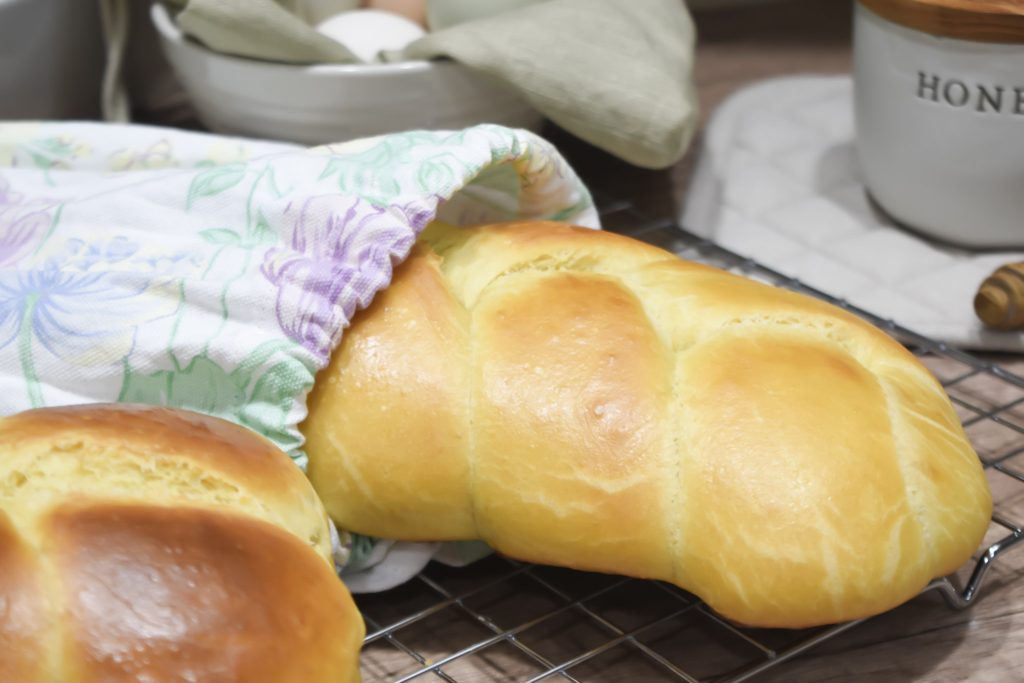
Linen or Cotton Bread Bags
This is hands-down my favorite way to store sourdough on the counter. Linen bread bags let the bread breathe without drying it out too fast.
The fabric helps pull a little moisture away from the crust so it stays crisp without turning soggy. I found a set of linen bags online and haven’t looked back since. That’s my go-to storage during the humid summer months.
If you don’t have a bread bag, just wrap your loaf in a clean dish towel and place it cut-side down on a wooden board. That works almost as well.
Paper vs. Plastic: Which is Better?
I’ll keep this simple: paper > plastic when it comes to sourdough storage.
Paper bags (like the kind you get from the bakery) are great for letting the bread breathe while still giving it some protection. They keep the crust from getting too soft, and you can always toss a towel over it for extra help.
Plastic bags? I avoid them unless I’m freezing the bread or if I know the kids will devour the loaf within a day or two. They trap in too much moisture, and by the next day, your once-crunchy crust is soft and chewy in the worst way. Plus, they can create the perfect little sauna for mold to grow. Gross.
Bread Boxes and Sourdough-Specific Containers
Ah, the good old bread box. Bread boxes create a little micro-climate for your loaf—dark, dry, and just the right amount of air circulation.
If you want to get fancy, there are sourdough-specific containers out there with vents and moisture control. I haven’t tried them (yet), but I’ve heard good things. Honestly, my basic wooden box with a hinged lid does the job just fine.
DIY Tips for Low-Humidity Climates
If you live somewhere dry, like Arizona or Colorado, your bread might dry out faster than it molds. That’s a totally different problem.
Here’s what I’ve found helps:
- Store your sourdough in a linen bag, inside a closed cabinet or pantry. That little bit of extra darkness and enclosed space slows down drying.
- You can also wrap it in a towel, then put it in a Dutch oven with the lid on. It’s not airtight, so it won’t trap moisture, but it keeps air out just enough.
- If you’re desperate? Add a slice of apple to a paper bag with the bread for a few hours. It adds a little moisture (just don’t leave it in there too long or… mold city).
Using the right storage can add 2–3 days to your loaf’s life—and keep it tasting fresh enough for toast, sandwiches, and even French toast. Speaking of stale bread…
What to Do With Stale Sourdough Bread
So, your sourdough’s a few days old. The crust is hard, and the inside’s dried out. Don’t toss it! Stale sourdough is basically a secret weapon in the kitchen—perfect for crunchy add-ons, cozy breakfasts, and even savory dinners.
Recipe Ideas: Croutons, Breadcrumbs, French Toast, Stuffing
Here are my go-to ideas for using up every last crumb:
Croutons – Cube the bread, toss with olive oil, salt, garlic powder, and herbs. Bake at 375°F for 15–20 minutes, flipping halfway. These are amazing on soups and salads. I once added parmesan before baking and it changed my life.
Breadcrumbs – Break the bread into chunks and blitz it in a food processor. If you don’t have one, use a cheese grater (yep, it works). Toast them in a dry pan or bake ‘em for a few minutes until golden. Keep them in a jar for topping pasta or casseroles.
French Toast – Thick slices of stale sourdough are perfect for this. They soak up the custard without falling apart. I mix eggs, milk, cinnamon, and vanilla, then fry the slices in a little butter. Crispy edges, soft inside… so good.
Stuffing – Especially during the holidays. I am not a stuffing fan but one of my friends that loves sourdough as much as I do swears by it. Cube it, dry it out even more in the oven, and mix with sautéed onions, celery, broth, and herbs, and there you have it! You can even make a sourdough stuffing bake with mushrooms and cheese. Total comfort food.
Refreshing Stale Bread in the Oven
If you want to just bring the bread back to life as-is, this trick has saved me more than once:
- Lightly spritz the loaf with water (not too much—just a mist).
- Wrap it in foil and bake at 300°F for about 10–15 minutes.
- Unwrap and bake another 5 minutes if you want the crust to crisp back up.
It won’t be just like fresh-baked, but it’ll be a lot better than chewing on cardboard.
Avoiding Food Waste With Creative Uses
The more I bake, the more I hate wasting food. Sourdough takes time, effort, and ingredients, so it stings to throw any of it away.
I’ve even used stale sourdough in:
- Bread pudding (sweet or savory)
- Grilled cheese—use slices that are almost too dry to eat, but still good for toasting
Honestly, once you know how to reuse it, stale sourdough becomes kind of exciting. It’s not trash—it’s an ingredient.
FAQs: How Long Does Sourdough Bread Last?
- How long does sourdough bread last at room temperature?
Homemade sourdough bread typically lasts 3 to 5 days at room temperature if stored properly. Use a linen bread bag, paper bag, or wrap it in a clean kitchen towel to maintain crust texture and avoid mold. - Should sourdough bread be refrigerated?
Refrigerating sourdough is not recommended because it can cause the bread to dry out quickly. If you must refrigerate due to a hot or humid climate, wrap the bread well in beeswax or foil and reheat before eating. - What’s the best way to store sourdough bread to keep it fresh?
The best way to store sourdough is in a linen bread bag, a paper bag, or a bread box. These methods help prevent moisture buildup, which can cause mold, while keeping the crust from going soft. - Can you freeze sourdough bread?
Yes! Sourdough bread freezes well for up to 3 months. You can freeze it whole or sliced. Just wrap it tightly in plastic or foil and use a freezer-safe bag. Thaw at room temperature and reheat to restore the crust. - How can you tell if sourdough bread has gone bad?
Look for mold, off smells (like sour milk or vinegar), and strange textures like stickiness or sliminess. A hard or dry loaf may just be stale and can still be used in recipes like croutons or French toast. - What causes sourdough to mold quickly?
Mold grows faster in warm, humid environments or when bread is stored in airtight plastic. Always let sourdough cool completely before storing and avoid plastic bags unless freezing. - How do I store sourdough bread without using plastic?
You can store sourdough without plastic by using a linen or cotton bag, wrapping it in a clean towel, or placing it in a wooden bread box. These options allow airflow while protecting the crust. - Can you refresh stale sourdough bread?
Yes! Lightly mist the loaf with water, wrap it in foil, and heat it in the oven at 300°F (150°C) for 10–15 minutes. This will revive the interior and crisp up the crust. - What’s the best container for storing sourdough bread?
A bread box or a ventilated container is ideal. Avoid airtight containers for room temp storage, as they trap moisture and speed up spoilage. For freezing, use airtight freezer bags. - How should I store sourdough bread in a dry climate?
In low-humidity areas, sourdough can dry out quickly. Store it in a linen bag inside a Dutch oven or a closed cabinet to slow moisture loss. You can also refresh slices in the oven when needed.
Final Thoughts on Keeping Sourdough Fresh
If there’s one thing I’ve learned from baking sourdough for years, it’s that a little storage know-how goes a long way. With the right tools (hello, linen bread bag) and a few simple tricks, you can easily keep your sourdough fresh for days—and make the most of every slice, even the stale ones.
Whether you’re storing it at room temperature, freezing slices for later, or figuring out if that forgotten loaf in the pantry is still safe to eat, sourdough bread doesn’t have to be tricky. And honestly? The more I bake, the more I see stale bread as an opportunity, not a loss. French toast, stuffing, crispy croutons—there’s always something delicious you can make.
So go ahead and bake that big loaf. You’ve got the tips now to store it like a pro.

